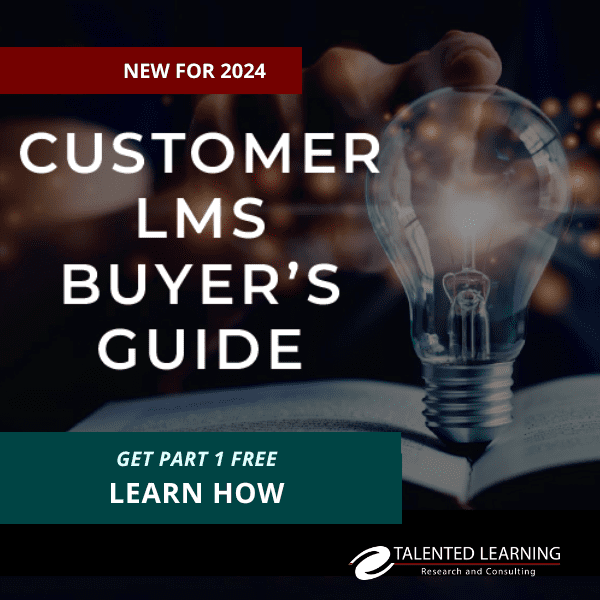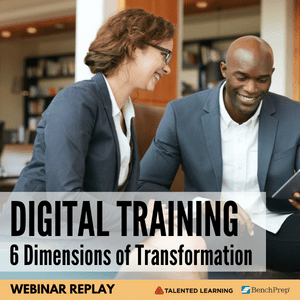
Do you want to grow your business? Then let me share a secret. If you are not familiar with the direct connection between customer success and customer training, then you’re probably working way too hard to reach your goals. And here’s why…
“Customer education is the scale engine for customer success”
Those are wise words from Slack’s Director of Enterprise Customer Learning & Enablement, Adam Avramescu – one of today’s foremost voices in the customer education space.
But what does it actually mean? What makes customer education so important? Is this only appropriate for fast-growth companies like software developers? Or can any organization benefit from this point of view?
Today I’d like to tackle these questions with excerpts from conversations I’ve had with two other professionals who understand why customer education is a central pillar of customer success.
- Brittany Tamul, Director of Customer Success at ArrowStream, a supply chain software company that helps foodservice organizations understand and manage inventory, procurement and other vital aspects of their business operations. Their customers include popular restaurants like Dairy Queen and Shake Shack, as well as numerous food industry suppliers and distributors.
- Samma Hafeez, Senior Director of Sales and Customer Success Center of Excellence at Insight Partners a venture capital firm that invests in high-growth technology companies. Previously, Samma was VP of Customer Success at Thought Industries, a learning platform provider that helps businesses educate their external audiences. That’s when we met and discussed this topic.
Do you want more information and analysis on the top 40 learning systems in the world? Buy our 2023 Corporate Learning Systems Market Update report – now available through the 2nd half of this year at a 50% discount!
What Is Customer Success?
Samma views customer success as much more than a buzzword.
“Historically, many companies relied on account management methods that focus solely on customer renewals and churn,” she notes. “But now, more businesses are moving to subscription models, and investors are less maniacal about focusing exclusively on topline revenue growth. Instead, they see value in focusing on customers’ desired business outcomes. So this is why customer success is gaining traction.”
In other words, when your customers achieve their goals, your business will also flourish as a byproduct of those results. This is the promise of customer success.
Brittany shares this worldview, but she’s also realistic about the challenges of helping customers succeed with sophisticated business software.
“Because our product is fairly complex, it’s essential for us to help people understand how they can use it to its fullest for all of their supply chain management tasks,” she says.
This is why product training plays such an integral role in ArrowStream’s strategy for customer onboarding, adoption, retention and renewals. And the company does not charge extra for customer education.
“We include training with our services,” Brittany explains. “We are committed to customer success. So you’re not just purchasing our software, you’re purchasing the team behind it. And training is a big part of that. We want our customers to be successful without barriers.”
How Does the Customer Success Function Work?
According to Samma, there is no obvious one-size-fits-all model. However, a customer success function should be measured on its ability to positively influence product adoption, customer retention and expansion. And this mission begins as soon as a contract is signed.
“We’re responsible for ensuring that customers realize value from their initial investment,” she says. “So we strive to be the means to each organization’s end goal.”
“We do that by driving behavioral change, considerable growth, and ultimately operational transformation,” she continues. “It happens through a series of onboarding, training, professional services and support activities available to customers throughout their relationship with the company.”
For an expansive model like this to work, Samma believes that customer success must be a core value that is woven into an organization’s culture and operations. “I don’t think there’s any other way for a SaaS company to operate in today’s highly competitive, dynamic and transparent business environment,” she says.
At ArrowStream, customer success translates into frontline training and support. “For us, customer success and customer education work together as core functions of our organization,” Brittany explains.
“Technically, customer success is housed within our client services division. But I like to think that I’m loosely involved with account management, as well. That’s because I also work as an extension of the customer support team, helping account managers address customer expectations and relationships for successful results.”
What Role Does Onboarding Play in Customer Success?
According to Samma, it’s important to understand the concept of onboarding in the context of customer success.
“Onboarding is not just training – although training is certainly fundamental to providing your customers with an engaging, outcome-driven experience. But it’s really an accumulation of efforts that successfully enable your customers to adopt your product in a meaningful way.”
In other words, onboarding is a multi-faceted process – as opposed to training, which is only one aspect of the onboarding process. Other aspects of software onboarding could involve data migrations, integrations or customizations.
As Samma explains, “There’s often a lot of technical legwork required to embed new software or technology into the native workflow of an organization’s ecosystem.”
At ArrowStream, implementation is a critical piece of the onboarding equation, but Brittany estimates that an equal amount of time and effort is focused on reinforcing skills, strengthening product utilization and encouraging retention among existing customers.
She explains, “As we introduce new modules and applications into our suite of services, it’s an opportunity to offer customers continuing education. It’s also a chance to provide refreshers that underscore what users can do to maximize the business value of their relationship with us.”
Do you want more information and analysis on the top 40 learning systems in the world? Buy our 2023 Corporate Learning Systems Market Update report – now available through the 2nd half of this year at a 50% discount!
Where Does Product Training Fit In?
In Samma’s opinion, smart companies focus on figuring out exactly who needs to be trained and how much training they actually need. In other words, for software companies, “Rather than trying to train your entire customer universe on every feature, when you have a new release, you identify the personas who will find the most relevance in that functionality. Then improve the way those user segments interact with your system, so they can put the features to use more quickly and effectively.”
Of course, this kind of strategy is hard to implement without a digital learning platform. And that’s the primary reason why Brittany’s organization has shifted from classroom training to a hybrid model.
“Previously, all our customer education was an in-person experience,” she explains. “We’re a customer-centric organization. And what better way to showcase this than by putting our personnel face-to-face with customers for training?”
But that model has its limits. As Brittany says, “‘Scalable’ is another keyword at our company. We’ve seen strong growth, and we want to retain our strong customer retention rate as we grow. In fact, our customer retention has been 100% since 2013, while our growth rate has been nearly 40% over the past 3 years. So we recognize that for the long-term, we need a scalable model for learning.
Now, with Thought Industries as our platform, we’re still able to provide a personal touch through instructor-led training, but also deliver foundational product knowledge through online learning courses and modules.”
How Can Online Learning Impact Customer Education?
Samma says, “For SaaS companies that are constantly releasing new features and functionality, it is very challenging to scale training. You might have hundreds or thousands or millions of customers. Using your finite resources, how do you deliver continuing education to all of those diverse users across the entire customer lifecycle?”
“For an end-user to continue engaging with your training program, it has to be accessible and dynamic and digestible. Folks don’t want to take long courses or go through PowerPoints or long narratives like manuals.”
“You have to deliver highly relevant, useful, timely microlearning-type interactions. That’s why we see more companies landing at the doorstep of learning technology companies.”
Brittany underscores this point with metrics that convinced ArrowStream that adding an online learning platform was a wise move.
“A great example is how we approach introductory product training. Previously during implementation, new customers would complete about 13 hours of instructor-led training. This required 13 hours of time from our staff.”
“Now, by weaving digital content into that product introduction process, we’ve reduced our ILT staff commitment from 13 hours to 9 hours. So that’s a decrease of 40%. Yet, we’re still able to give customers a positive experience that includes some instructor-led training. And customers save time, too. Because their adjusted investment in implementation training is reduced from 13 hours to 10.5 or 11 hours. So it’s a win-win.”
How Else Does Online Learning Help?
ArrowSteam is tracking several other metrics that reveal strong interest in online learning content. For instance, the digital learning platform has seen a 182% increase in customer logins since its launch.
Brittany explains, “We see learners returning to the platform for knowledge. We also see new learners entering every month, which contributes to that 182% increase in adoption. This tells us our content is helping customers improve their use of our system, so they can maximize its value for their organizations.”
Another adoption metric focuses on the demand for in-person training. Before its learning system launch, ArrowStream’s training team delivered 15-20 in-person product introduction sessions a month to new customers.
Now, the frequency has dropped to only 3-5 sessions a month – a 74% decrease in ILT training requests. This indicates that online training enables new customers to get started and work successfully in the system without additional live training.
There are qualitative benefits, as well. For example, the shift to a hybrid learning model has changed the nature of communication with new customers, Brittany says.
“Because they gain baseline knowledge online, our in-person conversations with new customers no longer revolve around questions like, ‘What does this button do?’ Instead, questions are more strategic.
For example, ‘How does this button drive value back to my organization?’ Or, ‘How can this function help me uncover opportunities to drive more growth for my organization?'”
As Samma sees it, incremental improvements like these can ad-up in ways that make a measurable difference in customer relationships and a company’s long-term viability.
“The subscription economy has arrived,” she says. “We’re all used to the Netflix model. It’s easy to initiate a software trial through a monthly or annual subscription. That means it’s also a little easier to acquire a customer because they don’t have to make a lump-sum upfront investment.”
“On the other hand, everyone knows other options are available, and switching is easier,” she continues. “So this means software providers need to work harder operationally, to keep customers because every interaction is essentially a resale of your product.”
Conclusion
Customer success is rapidly becoming a standard practice for businesses everywhere – especially for companies that want to gain a competitive advantage in volatile markets like software and technology. The logic is simple – by building strong relationships with customers and helping them meet their objectives, your company will, in turn, achieve its goals.
Customer education should be the cornerstone of any customer success strategy, and with good reason. Because no matter how simple or complex your product may be, the sooner your customers realize value from that product, the longer and more profitable your relationship is likely to be.
Get ready to scale!
Thanks for reading!
Share This Post
Related Posts
Top LMS Selection Speed Bumps: Customer Ed Nugget 18
If you're a customer education leader, sooner or later you'll need to choose a learning system. How can you avoid LMS selection speed bumps? Find out in this Customer Ed Nuggets podcast
CEdMA Conference Takeaways: Customer Ed Nugget 17
What's top-of-mind among customer education professionals these days? Join Analyst John Leh and industry leader Kristine Kukich as they compare notes from the recent CEdMA Conference
The Future of Customer Education: Customer Ed Nugget 16
Customer education is rapidly evolving as organizations embrace new strategies and tech. What does this mean for the future of customer education? See what experts say on this Customer Ed Nuggets episode
Education Strategy Mistakes to Avoid: Customer Ed Nugget 15
What does it take to deliver a successful customer education program? It starts with a solid education strategy. Learn how to avoid common pitfalls on this Customer Ed Nuggets episode
Which LMS is Best for You? New Shortlisting Tool for 2024
How can you find the best learning system for your business? Our LMS shortlisting tool can help. Learn about the 2024 RightFit Solution Grid. Free, reliable guidance based on our independent research
How to Build a Learning-Based Business: Executive Q&A Notes
Building and selling online courses may seem easy, but building a profitable learning-based business is far more complex. Find out what successful leaders say about running this kind of business
The Rewards of Community Building: Customer Ed Nugget 14
What role does community play in your customer relationships? Find out why community building is such a powerful force in customer education on this Customer Ed Nuggets episode
Benefits of Training Content Syndication: Customer Ed Nugget 13
If you educate customers online, why should you consider content syndication? Discover 10 compelling business benefits in this Customer Ed Nuggets episode
Top Marketing Skills to Master: Customer Ed Nugget 12
Successful customer education programs depend on professionals with expertise in multiple disciplines. Which marketing skills lead to the best results?















FOLLOW US ON SOCIAL